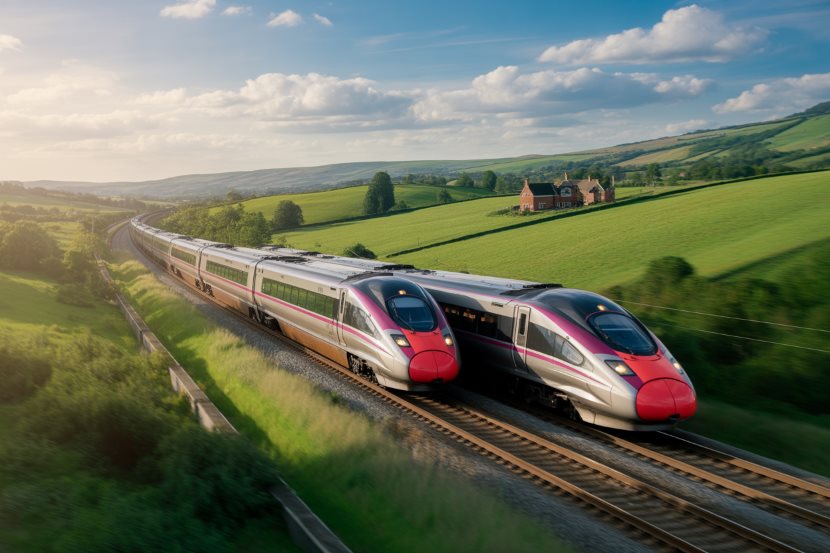Home » RAILWAY NEWS » New High-Speed Trains To Connect Germany nd Denmark with Speed and Comfort, Starting Soon
Published on
August 12, 2025
Spain’s Talgo 230 high-speed trains have just earned the final safety nod from the EU Railways Agency and Germany’s Eisenbahn-Bundesamt. This marks the way for faster, seamless European rail travel, and it’s especially exciting for the busy corridors of Northern Europe. The elegant, Spanish-designed units will soon glide into Germany and Denmark, introducing a new, speedy standard for the continent’s busiest routes.
The green light is the latest step in a plan that kicked off in 2019, when Talgo signed contracts with Germany’s Deutsche Bahn and Denmark’s DSB to supply the sleek trains. Now, the Talgo 230 fleet will merge with Deutsche Bahn’s ICE L and EuroCity services, knitting together major cities with even tighter schedules. Expect smoother connections between Hamburg, Copenhagen, and other key hubs, lifting international travel to a new level.
Bridging Borders with a Spanish Touch
These trains are a testament to Spain’s growing prominence in the rail industry. Designed and manufactured entirely in Spain, the Talgo 230 represents a leap forward for the Spanish rail sector, traditionally overshadowed by Germany and France in rail manufacturing. Each train has been meticulously engineered at Talgo’s factory in Ribabellosa (Álava), bringing a sense of pride to Spain’s rail industry, which now competes in the European high-speed market.
With the EU and EBA approvals now in place, passengers can expect to see the Talgo 230 trains in operation within months. These trains will serve Deutsche Bahn’s ICE L service and DSB’s EuroCity cross-border routes, initially running with locomotives from both companies. Future plans involve the Talgo 230 operating with Talgo’s own electric locomotives, currently undergoing separate homologation processes.
Key Features of the Talgo 230 Trains
Unlike other high-speed trains, the Talgo 230’s emphasis isn’t solely on speed. While the 230 km/h maximum speed is certainly competitive, the true value of these trains lies in their design and functionality. The Talgo 230 trains are lightweight, with quick acceleration and efficient braking, which significantly improves punctuality and minimizes delays. The low-floor design makes boarding a breeze, with step-free access that caters to all passengers, including those with reduced mobility or heavy luggage.
Moreover, the modularity of these trains means that Talgo can tailor train configurations to meet demand. Whether during peak commuting hours or quieter times, the trains can be configured with 9 to 21 coaches to optimize capacity. This flexibility will ensure that passengers can enjoy a more comfortable, stress-free journey, whether they’re traveling alone or with family.
A Sustainable Future for Rail Travel
Beyond the convenience and comfort, the Talgo 230 trains are a significant step in reducing Europe’s reliance on short-haul flights. As part of the ongoing effort to make rail travel a more sustainable alternative to air travel, the cross-border capabilities of the Talgo 230 will make it easier for travelers to move between countries without the hassle of border controls or the environmental impact of flying.
Currently, Talgo is pushing for further national safety authorizations in countries such as Austria, the Netherlands, and Switzerland. Once these approvals are granted, the network will expand to include more routes, potentially connecting even more cities across the continent with high-speed rail. This expansion aligns with the broader goal of reducing aviation in favor of more environmentally friendly rail options on European routes that typically span between three to six hours.
Commercial Success in the Pipeline
The commercial prospects of the Talgo 230 are growing. Alongside the orders from Deutsche Bahn and DSB, Munich-based Flix has signed a deal worth approximately 2.4 billion Euro for up to 65 Talgo 230 high-speed trains. The first batch of 30 trains will be delivered by Talgo, signaling a major shift in the European rail market towards greater connectivity and higher capacity on intercity routes.
Talgo’s platform for the 230 series is also attracting interest in other European regions, with its adaptability to various power systems, voltage types, and locomotive configurations making it a versatile option for other national rail operators. The trains’ impressive design and efficient operation are also contributing to growing confidence in their potential to dominate cross-border services in Europe.
Future of European Rail Travel
Travelers booking tickets between Germany and Denmark will soon meet the Talgo 230 trains and discover more than faster trains: they’ll find a journey designed for ease and comfort. These new trains glide across borders without long waits, offer extra seats when demand rises, and feature on-board services that travelers increasingly expect. As a result, every leg of the trip from a quiet morning coffee to a smooth evening arrival becomes more enjoyable.
Over time, they will help the vision of a more connected Europe move from plans to reality. Germany, Denmark, and their neighboring countries will gain closer ties, lower carbon footprints, and more time for travel that feels less like a chore. Each new country that orders the Talgo 230 trains adds another link to the chain of fast, green travel that Europe’s expanding rail map now promises.
Thanks to Talgo’s momentum, the next few years will usher in a pleasant change: the rail option will become the natural choice when a city feels just a few hours away. Families, business travelers, and tourists will leave the compact airplane for a spacious carriage, watch the countryside glide by, and arrive more relaxed while leaving the planet a little healthier.
